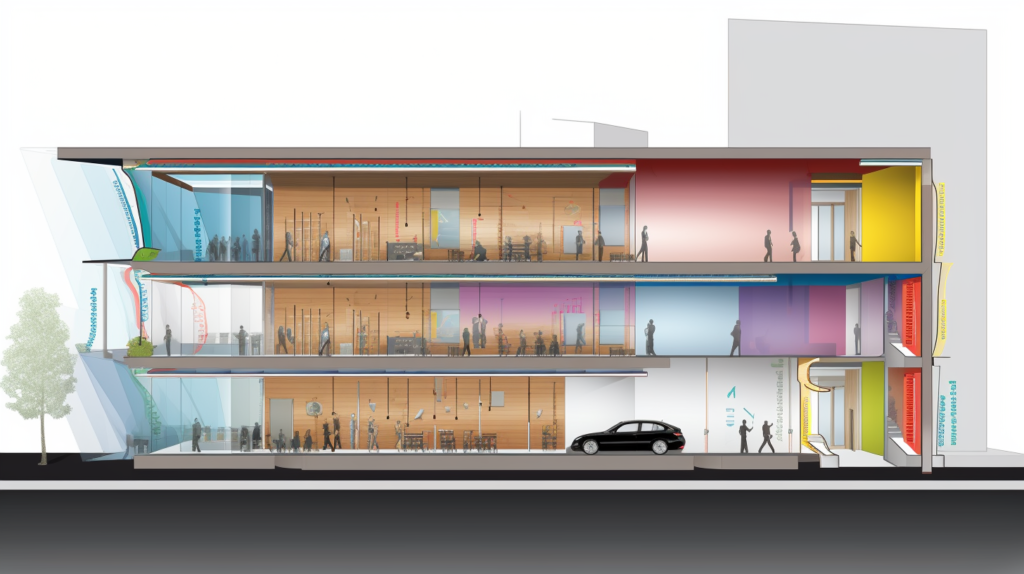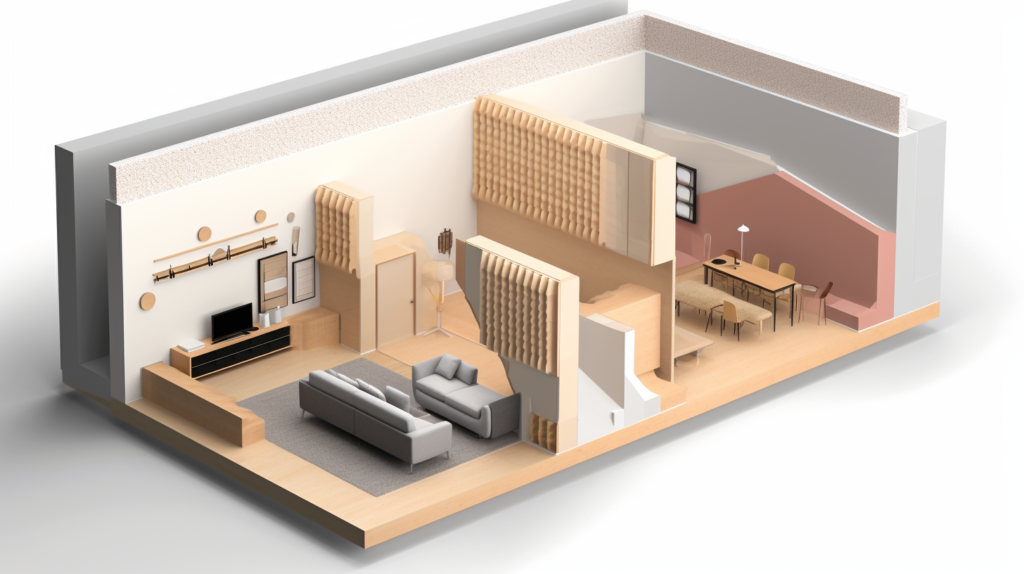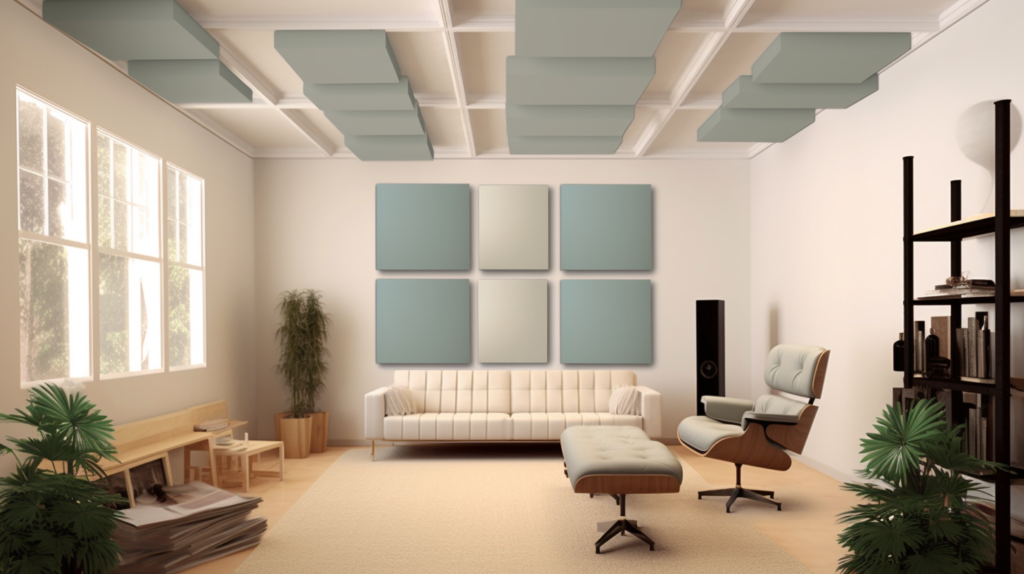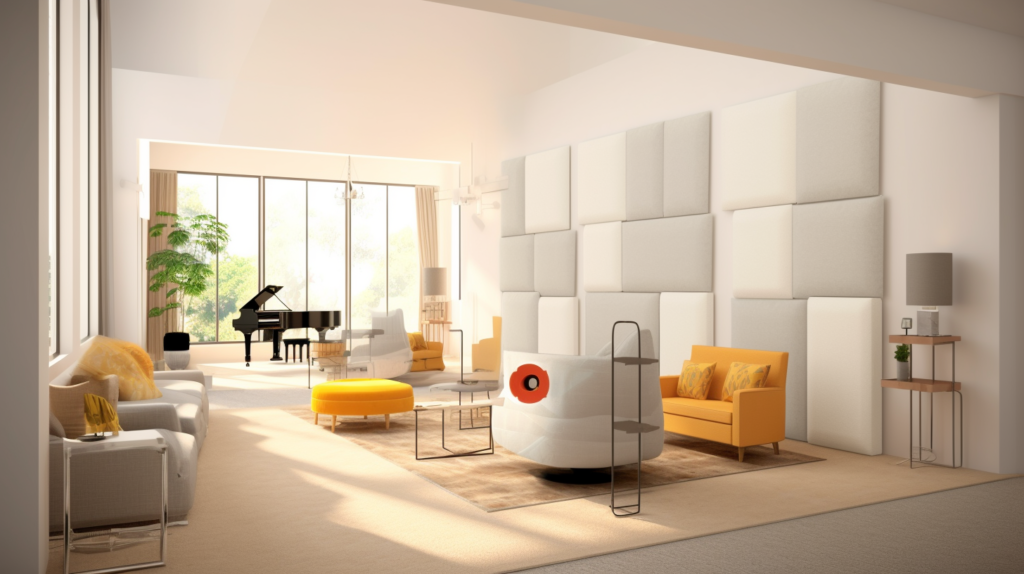Loud neighbors keeping you up at night?
Traffic noise driving you crazy?
Acoustic panels may seem like the solution for blocking irritating sounds, but look before you leap.
Acoustic panels alone cannot block outside noise and prevent it from entering a room. They are designed to absorb and reduce noise once inside a space, not soundproof exterior walls.
For true noise blocking, acoustic panels need to be combined with specialized soundproofing materials and construction techniques.
In this article, we’ll cover why acoustic panels fall short in blocking noise from the outside, how they can help control interior sound when properly paired with sound barriers, and the best practices for total noise control using both absorption and blocking.
Let’s explore the limitations and ideal uses of acoustic panels for reducing noise.
Do Acoustic Panels Block Outside Noise?

Acoustic panels are made from porous, sound-absorbing materials like foam, fiberglass, or mineral wool. The porous structure of acoustic panels allows sound waves to pass through rather than blocking them.
Acoustic panels do not act as an effective sound barrier or noise blocker to prevent noises from the outside from entering a room.
When mounted on walls and ceilings, acoustic panels are designed to absorb, diffuse, and reduce noise through sound absorption once the sound waves are already inside a room.
However, the panels do not block exterior noises from intruding in the first place.
Outside sounds like traffic, construction, loud neighbors, or barking dogs can still penetrate into a space through windows, doors, thin walls, and other openings despite having foam or fiberglass acoustic panels installed.
Why Acoustic Panels Don’t Block Outside Noise?

The reason acoustic panels fail to block outside noise is that their porous, open-cell structure permits sound energy to pass through the material rather than reflecting it back.
The sound waves essentially enter one side of the acoustic panel and exit out the other side rather than being blocked.
This allows external noises to make their way into a room from outside relatively unimpeded.
While acoustic foam and fiberglass panels can help absorb echoes and reduce the reverberation of noises within a room, they do not prevent noise ingress from exterior sources.
Sounds find their way through the multiple gaps, cracks, openings, and thin walls of a building.
Once inside a space, acoustic paneling can then work to absorb some of the sound energy and reduce excess reverberation.
However, the panels themselves do not block the sound
Acoustic Panels Treat Interior Noise Only
So while acoustic panels are very effective for controlling sound within a room, they should not be expected to reduce the noise coming from the outside in the first place.
Exterior sounds can easily travel through walls, windows, and doors and penetrate into a space. Installing foam or fiberglass acoustic panels alone will not prevent this noise transmission.
Supplementary sound-blocking techniques are required to stop sound transmission of noise from outside the apartment.
Then, Do Acoustic Panels Keep Sound In?

So while acoustic panels are very effective for controlling sound within a room, they should not be expected to reduce the noise coming from the outside in the first place.”
Then, do acoustic panels keep sound in?
While acoustic panels are porous and allow sound to pass through, they can help reduce the transmission of sound from inside a room to the outside when installed on walls and ceilings.
The sound-absorbing materials used in acoustic panels convert some of the sound energy into heat, which reduces the noise level inside the room.
This can decrease the amount of noise that radiates through walls, doors, and windows to the outside.
Strategically placed acoustic foam panels help absorb and diffuse sound waves within a room which reduces the noise coming from inside that space. The panels attenuate internal sound through absorption rather than blocking noise transmission completely.
Acoustic panels alone are not an effective soundproofing solution to contain noise inside a room.
But as part of a multifaceted approach, acoustic treatment can help reduce sound transmission alongside proper construction sealing techniques.
So acoustic panels do help reduce noise leakage from a room but should not be solely relied on to keep interior sound contained without additional sound-blocking methods.
Their sound absorption qualities can make some difference in noise radiating externally when installed correctly inside the space.
Combining Acoustic Panels and Soundproofing Materials to Block Outside Noises

To effectively block exterior noises from entering a room, acoustic panels need to be combined with proper soundproofing materials and construction methods.
Installing insulation, using acoustic caulk to seal gaps, upgrading to soundproof windows and doors, and ensuring all openings are airtight can help prevent outside sound from penetrating into a space.
Once noise makes its way into a room, acoustic panels can then work to absorb some of the sound energy through their porous structure and reduce excess reverberation.
But the panels alone are not enough to stop sound from the outside.
Strategically placed soundproofing panels or fiberglass panels complement noise-blocking techniques by controlling the room’s acoustics and absorbing residual noise that manages to enter despite the best soundproofing efforts.
A Multifaceted Soundproofing Approach Is Needed to Reduce The Amount Of Noise Coming In
A multifaceted approach using both acoustic panels and sound barriers like insulation, heavy curtains, and airtight seals provides the most effective overall solution for reducing noise from exterior sources.
The acoustic panels treat the interior space while construction techniques block noise on the perimeter. This balanced approach delivers optimal noise control and sound absorption.
Acoustic Panels Alone Are Incomplete
Relying solely on acoustic panels without addressing potential air gaps, leaks, thin walls, and openings would be an incomplete strategy.
Noise blocking must be coupled with acoustic panel absorption to prevent intrusive exterior noises and manage sound once inside the room.
Properly installed panels can make a difference in perceiving noise that enters a space but should not be expected to soundproof on their own.
Using Acoustic Panels for Absorbing and Reducing Interior Noise

On their own, acoustic panels are very effective solutions for managing and optimizing the acoustics within a room.
Strategically mounting acoustic foam or fiberglass panels at problem locations on walls, ceilings, and other hard, reflective surfaces can help reduce excess reverb and echo.
The sound-absorbing qualities of acoustic panels are ideal for controlling common interior noise issues.
Acoustic panels treat a room’s acoustics by absorbing sound energy rather than reflecting it, reducing overall reverberation.
Unwanted noises from interior sources like speakers, voices, footsteps, or dogs barking can be absorbed and diffused rather than bouncing around the room.
This prevents an echo chamber effect and muddies disruptive noises.
Optimizing Interior Sound Quality
Well-designed acoustic paneling helps optimize sound quality within a room. Recording studios, theaters, and other performance spaces rely on acoustic panels to control sound reflections and ambiance. Panels mounted on bare walls and ceilings treat excessive reverberation and allow clear audio.
Managing Interior Acoustic Issues
Interior acoustic issues can be readily managed with the careful installation of acoustic paneling. Strategically placed panels will absorb stray sound waves and excessive reflections.
This fine-tunes the room’s acoustics for activities like musical performances, listening to audio, recording podcasts or videos, and voice calls.
However, it’s important to note that acoustic panels alone have limited abilities when it comes to reducing noise from exterior sources outside of a room.
The porous panels can effectively absorb indirect sound inside a space but do not prevent that sound from entering in the first place. Additional soundproofing is required to block outside noises.
Acoustic Panels Don’t Block Outside Noises

In summary, acoustic foam and fiberglass panels are very useful and effective interior acoustic treatment options. They help optimize a room’s sound for recording, listening, and other applications.
But acoustic panels should not be expected to actually prevent outside noises from making their way through walls, windows, and into the room.
Their sound absorption capabilities are limited to within the interior space.
Acoustic Treatment Is Not Soundproofing
There is an important distinction between acoustic panels and proper soundproofing.
Acoustic panels are sound-absorbing materials installed within a room to control internal noise issues like echoes and reverberation. Soundproofing refers to methods of preventing exterior noise from entering a room in the first place. Effective noise control requires both approaches.
Acoustic panels alone will not soundproof a room from outside noises but can improve the interior acoustics once noise makes its way inside. Soundproofing such as insulation, weatherstripping, caulking gaps, and quality windows blocks noise ingress but does nothing for interior sound quality. Using both acoustic treatment and sound barriers provides the best of both worlds.
Different Noise Control Methods
Foam and fiberglass acoustic panels are designed to absorb rather than block sound.
They allow sound waves to pass through the material and convert some of that energy into heat through friction, providing sound absorption once inside a room.
Soundproofing materials like mass loaded vinyl physically block noise by presenting a dense barrier.
When recording audio, acoustic panels minimize excess reverb while soundproofing walls prevent background noise from bleeding through.
In home theaters, sound absorption panels reduce echoes while insulation stops exterior noise.
Bedrooms are soundproofed to block outdoor noise and treated with panels to absorb interior reverberation. A combination of absorption and blocking is the ideal noise control strategy.
Relying on One Method is Incomplete
Relying solely on acoustic panels will leave a space vulnerable to intrusive outside noises.
Depending on only soundproofing means interior sound quality will suffer.
The best practice is to use acoustic panels and sound barriers together to both prevent outside noises from getting in and manage noise once inside the room.
Prioritizing Sound Blocking and Absorption with Acoustic Panels

Determining the right balance of acoustic treatment and soundproofing comes down to priorities. Preventing outside noise from entering altogether should be the first priority in most cases.
Blocking noise ingress allows for a quiet, controlled interior acoustic environment. Acoustic panels can then work effectively to fine-tune the room’s sound.
Sealing air gaps, caulking openings, insulating walls, and installing soundproof windows are imperative to establishing a noise-controlled space.
Acoustic panels alone cannot compensate for thin, leaky walls or poorly insulated windows. Stopping noise at the perimeter is job one.
Once a room is adequately soundproofed from exterior noise intrusion, interior acoustic paneling can be installed to absorb any remaining noise and optimize the sound quality within the space.
Strategically placed panels will diffuse reflections and reverb.
Soundproof First, Then Add Acoustic Treatment
Trying to rely strictly on foam acoustic panels without addressing sound intrusion issues will lead to disappointing results.
Exterior noise will overwhelm the interior absorption capabilities of the panels. Adequate soundproofing must come first before fine-tuning with acoustic treatments.
Prioritizing noise blocking establishes a solid foundation for clear audio and controlled acoustics. Supplementing with acoustic panels then enhances the interior sound environment.
This inside-out approach delivers optimal noise control and absorption for spaces like recording studios and home theaters.
Achieving Effective Noise Reduction with Acoustic Panels and Sound Barriers
Here are some best practices for effective overall soundproofing using both noise-blocking and acoustic absorption:
– Seal all air gaps and openings with acoustic caulk to prevent noise intrusion.
– Insulate walls and ceilings with mass-loaded vinyl, Green Glue, or similar soundproofing barriers.
– Install thick, multilayered soundproof curtains over windows.
– Upgrade doors and windows with models designed to block sound.
– Use construction techniques like double-wall framing and isolation clips.
– Carefully place acoustic panels at reflection points on walls and ceilings.
– Prioritize blocking exterior noise before fine-tuning interior acoustics.
– Combine absorbing materials like panels with soundproofing barriers.
– Isolate noise sources like speakers away from walls and corners.
Stop Noise Ingress First
With diligence and proper installation, a space can be effectively shielded from outside noises while optimizing the interior acoustics.
Soundproofing blocks noise ingress so acoustic treatments can work unimpeded, allowing both noise control priorities to be met.
Conclusion: Acoustic Panels Don’t Block Outside Noises But Can Help Reduce Sound
Acoustic panels alone do not block outside noise from entering a room but they are effective at absorbing and reducing noise within the interior space once sound has entered.
To prevent exterior noise intrusion, acoustic panels need to be combined with proper soundproofing of windows, doors, air gaps, and insulation.
Absorptive materials like foam and fiberglass acoustic panels are great supplemental additions to help manage sound and optimize acoustics but should not be expected to replace proper sound barriers.
A holistic approach using both noise blocking and acoustic panel absorption delivers ideal noise control and sound quality.
